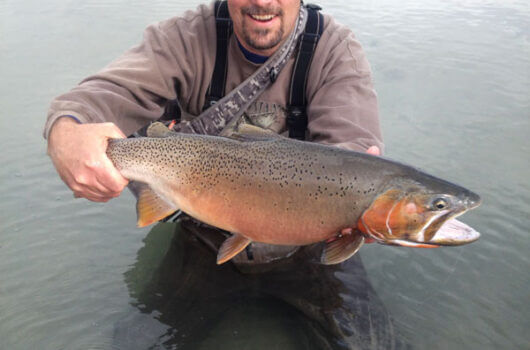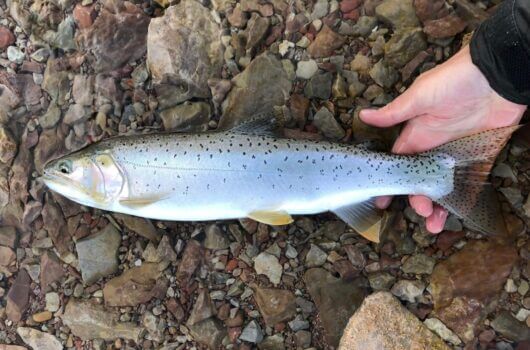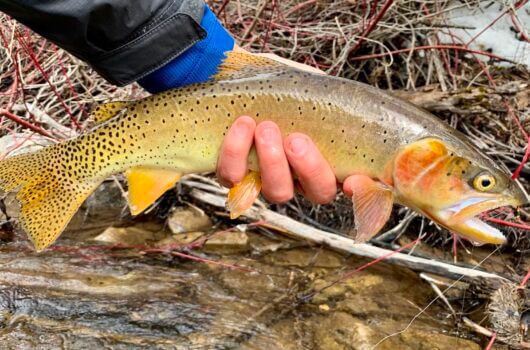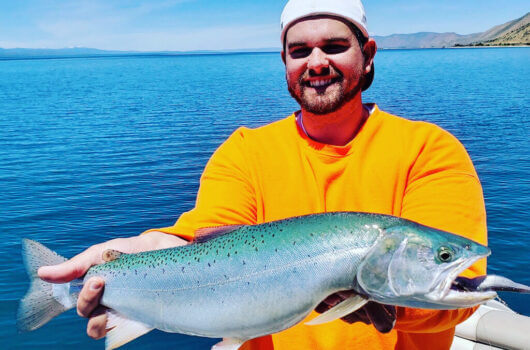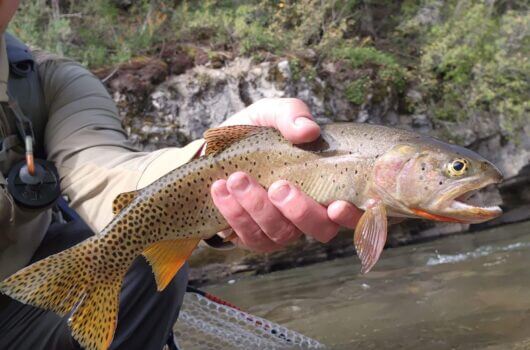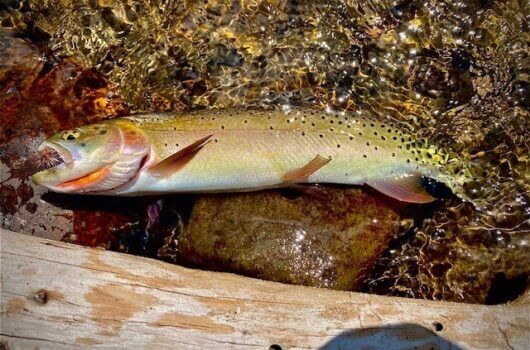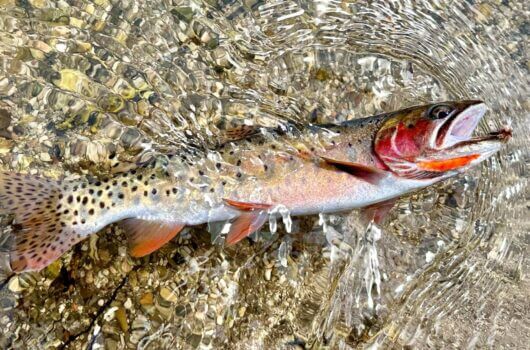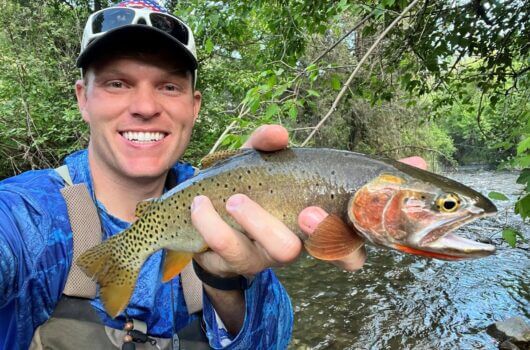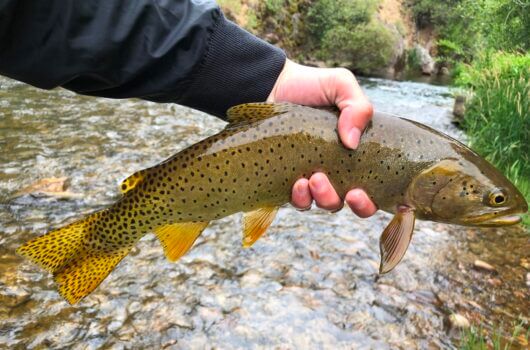Bear River
Product of Geological Change – Bear River Cutthroat
Oncorhynchus virginalis utah*
The Bear River/Bear Lake Cutthroat Trout is an interesting subspecies with a unique biological history. Even though the present day Bear River terminates in the Great Salt Lake within the Bonneville Basin, these cutthroat trout actually evolved on a separate path from the basin’s native Bonneville cutthroat trout.
Geologic evidence suggests that the course of the Bear River was changed approximately 20,000 years ago due to volcanic activity. Before this rerouting, the Bear River was connected to the Snake River drainage. This is supported by DNA evidence which suggests that the Bear River/Bear Lake cutthroat evolved from their closest relatives, Yellowstone cutthroat trout, the native of the Snake and Yellowstone River drainages.
For a time, it was thought that due to commercial overfishing, the Bear Lake cutthroat had gone extinct from Bear Lake, and that non-native fish were all that could be found within Bear Lake’s waters. But due to conservation efforts beginning in the 1960s and hatchery supplementation programs starting in the 1970s, these cutthroat have made an amazing comeback in the lake itself and in many of its tributaries.
Bear Lake cutts are known for their voracious appetites and can grow to impressive sizes. Because of their piscivorous nature (meaning they feast on smaller fish) they have actually been utilized in lakes outside their native range to control invasive Utah chub populations. The most famous example of this is their use in Strawberry Reservoir. So while you are likely to catch Bear Lake cutthroat at Strawberry, do keep in mind that for the purposes of the Slam, fish must be caught within their native range. Therefore, cutthroat caught from Strawberry Reservoir and its tributaries cannot count towards your Slams.
*Many agencies still lump these cutthroat in with the Bonneville cutthroat, since today they all fall within the same Bonneville Basin watershed. But as mentioned above, Bear River cutthroat are genetically their own individual subspecies that evolved separately from Bonnevilles, and that probably justifies them to someday receive their own trinomial scientific name.
Where to Find Bear River Cutthroat in Utah
To zoom in, open dialogue and click on “Bear River Cutthroat Trout”
Bear River cutthroat trout (BRCT) are native to the Bear River and its tributaries, including Bear Lake. While the Bear River terminates in the Bonneville Basin, these cutthroat trout have evolved on a separate path from other Bonneville cutthroat trout because of a historic stream capture of the Bear River from the Snake River to the Bonneville Basin. This native cutthroat trout subspecies remains abundant and additional pure populations are being protected/restored in Rich County through chemical restoration projects. While the Weber River (including the Ogden River) is not in the Bear River Drainage, the Bonneville cutthroat trout in these drainages historically mixed with Bear River cutthroat trout and cutthroat trout angled in these drainages can count toward either the Bear River or Bonneville cutthroat trout catch, BUT NOT BOTH. FOR EXAMPLE, IF YOU CLAIM A BEAR RIVER CUTTHROAT TROUT CATCH FROM THE WEBER RIVER, THEN YOU NEED TO CATCH A BONNEVILLE CUTTHROAT TROUT FROM A DIFFERENT DRAINAGE AND VICE VERSA. Any cutthroat trout caught while angling streams in the Utah portion of the Bear River and Weber River (including the Ogden River) drainages will be accepted as BRCT for the Utah Native Cutthroat Slam. Some headwater lakes in the Bear River have been historically stocked with non-native cutthroat trout. If you wish to angle BRCT from any headwater lakes, check with the Northern Region UDWR Office (801-476-2740) for a list of lakes containing native BRCT. The following areas/streams will provide the best opportunities to catch native Bear River cutthroat trout in Utah:
Upper Bear River: This is the headwater portion of the Bear River, including its major tributaries: East Fork, West Fork, Stillwater Fork, Hayden Fork, and Mill Creek. The majority of this area lies on the Uinta Wasatch Cache National Forest and is easily accessible.
Rich County:
1. Woodruff Creek Reservoir. This reservoir contains a strong population of native BRCT that can be caught from the shore or from a small boat. The boat ramp at Woodruff Creek Reservoir is rudimentary and the launching of anything but smaller boats is discouraged.
2. Big Creek. A strong population of BRCT remains in the headwaters of Big Creek, however portions of this stream are privately owned so please respect private property. Big Creek was treated chemically in 2018-2019 to remove nonnative brook trout and the BRCT population is still rebuilding; please contact the Northern Region UDWR Office (801-476-2740) for BRCT fishing opportunities in this stream.
3. Otter Creek (all three headwater forks). This stream was chemically restored to native BRCT during 2015-2016. Please contact the Northern Region UDWR Office (801-476-2740) for BRCT fishing opportunities in this stream.
4. Bear Lake. Bear Lake is being managed to provide a trophy BRCT fishery and angling opportunities for large BRCT are available year-round. Special fishing regulations are present on Bear Lake so check the Fishing Guidebook before planning a trip. Up to date fishing reports are available from the Bear Lake UDWR Field Station at 385-835-1104.
Cache County:
1. Logan River. The Logan River in Logan Canyon (upstream from 3rd dam to the headwaters) is managed for native BRCT. The majority of the Logan River upstream from 3rd Dam is on the Uinta Wasatch Cache National Forest. The densities of BRCT are strong in the Logan River and its tributaries making this a great destination to catch a pure, native BRCT. Special fishing regulations are present in the Logan River so check the Fishing Guidebook before planning a trip.
2. Blacksmith Fork River. A small population of BRCT remains in the Blacksmith Fork River. The Left Hand Fork, Rock Creek, and Curtis Creek, all tributaries of the Blacksmith Fork, contain larger populations of native BRCT.
Weber and Ogden Rivers: Special fishing regulations are present in portions of the Weber River Drainage so check the Fishing Guidebook before planning a trip.
1. Weber River from the confluence with the Ogden River upstream to Echo Dam is managed by the UDWR for native cutthroat trout (Bear River/Bonneville cutthroat trout). Land on the Weber is primarily privately owned but there are several points of public access through the Walk-In Access program.
2. Weber River and its tributaries from the town of Oakley, UT upstream to the headwaters is managed by the UDWR for native cutthroat trout (Bear River/Bonneville cutthroat trout).
3. Beaver Creek (upstream from Kamas) is managed by the UDWR for native cutthroat trout (Bear River/Bonneville cutthroat trout).
4. South Fork of the Ogden River is managed by the UDWR for native cutthroat trout (Bear River/Bonneville cutthroat trout).
5. Wheeler Creek. Angling conditions can be tough as Wheeler Creek is a small, brushy stream and is managed by the UDWR for native cutthroat trout (Bear River/Bonneville cutthroat trout).
6. Wolf Creek. Angling conditions can be tough as Wolf Creek is a small, brushy stream and is managed by the UDWR for native cutthroat trout (Bear River/Bonneville cutthroat trout).
Bear Lake Cutthroat Facts
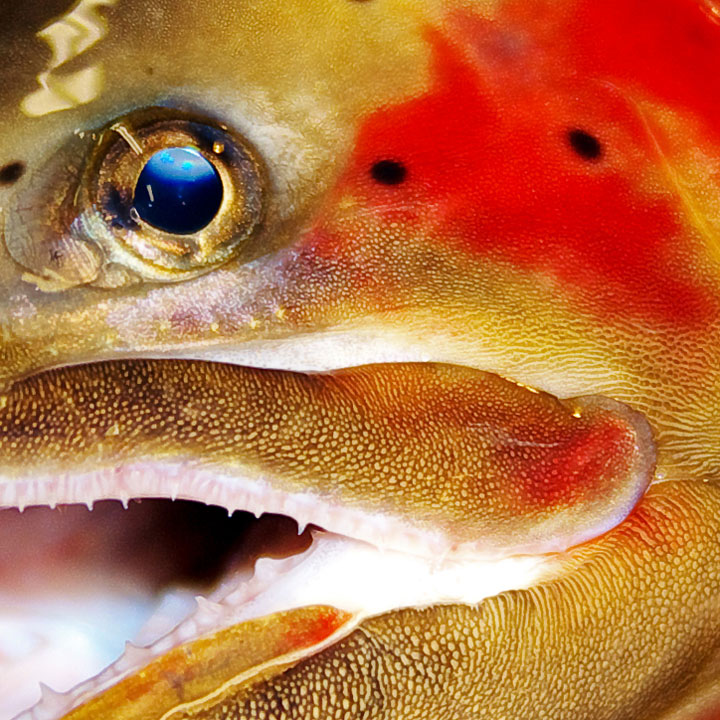
Considered by many to simply be a unique variety of Bonneville cutthroat, the Bear River cutthroat actually represent a unique strain closer related to Yellowstone cutthroat
Bear Lake Cutthroats are primarily piscivorous (fish eaters)
Introduced into waters like Strawberry Reservoir to control nuisance fish species
Historically called ``Blue Noses`` due to the blue color on the backs and head of lake dwelling fish
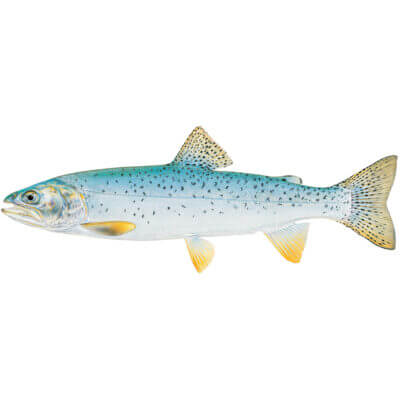
Photo by Joseph Tomelleri
Ready to Get Started?
The Utah Cutthroat Slam is a challenge and an adventure. Visit incredible waters to see what trout fishing in Utah was like way back then. Help Trout Unlimited and the Utah Division of Wildlife Resources restore and protect Utah’s incredible trout legacy and have fun along the way.
